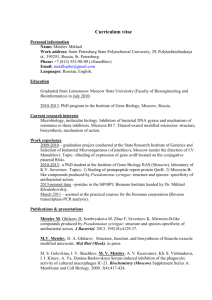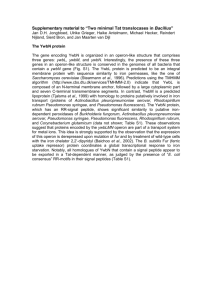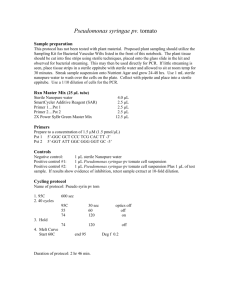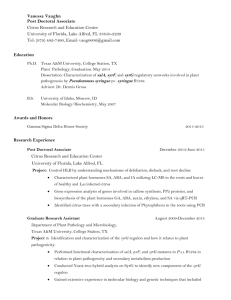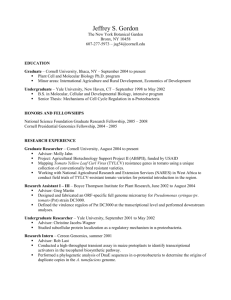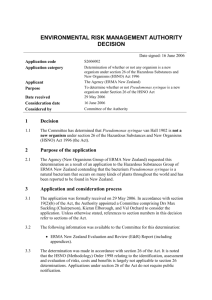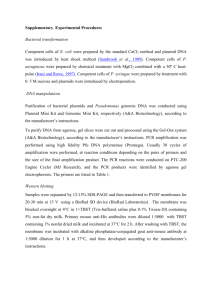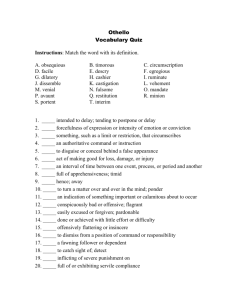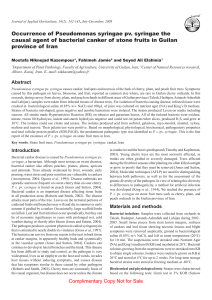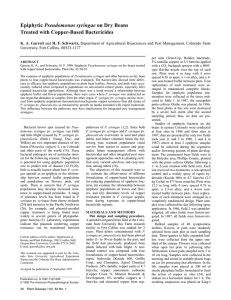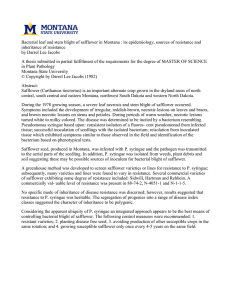Georgia Extension Vegetable News Cooperative Extension Service The University of Georgia
advertisement
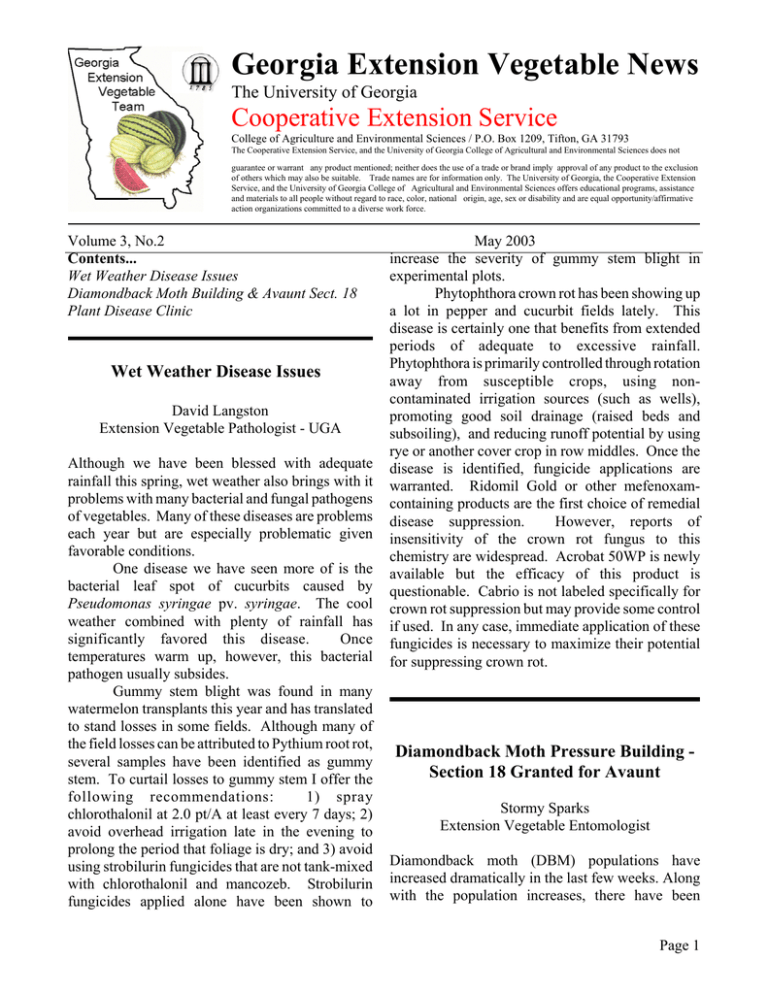
Georgia Extension Vegetable News The University of Georgia Cooperative Extension Service College of Agriculture and Environmental Sciences / P.O. Box 1209, Tifton, GA 31793 The Cooperative Extension Service, and the University of Georgia College of Agricultural and Environmental Sciences does not guarantee or warrant any product mentioned; neither does the use of a trade or brand imply approval of any product to the exclusion of others which may also be suitable. Trade names are for information only. The University of Georgia, the Cooperative Extension Service, and the University of Georgia College of Agricultural and Environmental Sciences offers educational programs, assistance and materials to all people without regard to race, color, national origin, age, sex or disability and are equal opportunity/affirmative action organizations committed to a diverse work force. Volume 3, No.2 Contents... Wet Weather Disease Issues Diamondback Moth Building & Avaunt Sect. 18 Plant Disease Clinic Wet Weather Disease Issues David Langston Extension Vegetable Pathologist - UGA Although we have been blessed with adequate rainfall this spring, wet weather also brings with it problems with many bacterial and fungal pathogens of vegetables. Many of these diseases are problems each year but are especially problematic given favorable conditions. One disease we have seen more of is the bacterial leaf spot of cucurbits caused by Pseudomonas syringae pv. syringae. The cool weather combined with plenty of rainfall has significantly favored this disease. Once temperatures warm up, however, this bacterial pathogen usually subsides. Gummy stem blight was found in many watermelon transplants this year and has translated to stand losses in some fields. Although many of the field losses can be attributed to Pythium root rot, several samples have been identified as gummy stem. To curtail losses to gummy stem I offer the following recommendations: 1) spray chlorothalonil at 2.0 pt/A at least every 7 days; 2) avoid overhead irrigation late in the evening to prolong the period that foliage is dry; and 3) avoid using strobilurin fungicides that are not tank-mixed with chlorothalonil and mancozeb. Strobilurin fungicides applied alone have been shown to May 2003 increase the severity of gummy stem blight in experimental plots. Phytophthora crown rot has been showing up a lot in pepper and cucurbit fields lately. This disease is certainly one that benefits from extended periods of adequate to excessive rainfall. Phytophthora is primarily controlled through rotation away from susceptible crops, using noncontaminated irrigation sources (such as wells), promoting good soil drainage (raised beds and subsoiling), and reducing runoff potential by using rye or another cover crop in row middles. Once the disease is identified, fungicide applications are warranted. Ridomil Gold or other mefenoxamcontaining products are the first choice of remedial disease suppression. However, reports of insensitivity of the crown rot fungus to this chemistry are widespread. Acrobat 50WP is newly available but the efficacy of this product is questionable. Cabrio is not labeled specifically for crown rot suppression but may provide some control if used. In any case, immediate application of these fungicides is necessary to maximize their potential for suppressing crown rot. Diamondback Moth Pressure Building Section 18 Granted for Avaunt Stormy Sparks Extension Vegetable Entomologist Diamondback moth (DBM) populations have increased dramatically in the last few weeks. Along with the population increases, there have been Page 1 reports of poor control with SpinTor and other products. However, in a small plot trial conducted at the end of April, several products provided good control at 48 hours after treatment, including SpinTor, Dibrom, and Mustang Max. Pretty much everything in the test look good to excellent at 6 days after treatment, including the B.t. product (Xentari). With DBM, the fact that a product worked well, or failed, in one location does not mean it will perform the same throughout Georgia. DBM can develop localized pockets of resistance to whatever products (or chemistries) they are regularly exposed. Frequently you can predict what will work in an area by looking at what has not been used there. Also, if you find one product that works well for you and stick with it, it will not last long. We recently obtained some additional help for fighting DBM. Working with the Georgia Department of Agriculture, we were able to finally get section 18 clearance for the use of Avaunt for DBM on collards. We started this process last fall with a request for both Avaunt and Proclaim, hoping to have two more products for resistance management. We got one, and we need to be careful with all of the insecticides we have to maintain as many efficacious products as we can. Most everyone should be familiar with Avaunt as it has been in use on cabbage for some time, but we can now use it on collards as well. For resistance management with DBM, try and keep B.t. products in your rotation (as a stand alone or tank mix), and remember that thorough coverage is a must. Coverage can also be an issue with some of the newer insecticides, and may be part of the reason we have had some reports of poor control. With all of our insecticides, about two applications with any one chemistry is all that should be used before switching to a different chemistry. If any product fails, stay away from that chemistry (a second application of the same or similar product wastes money and reinforces any resistance that exists). Remember to rotate chemistries (e.g. organophosphates and carbamates, pyrethroids, endosulfan, SpinTor, and Avaunt) not trade names (e.g. Asana, Ambush, Mustang and Ammo are all pyrethroids and should not be rotated - use one and switch to a different chemistry). Preferably, the gap between the second application and the next application of a chemistry should be 3 to 4 weeks for DBM. With the many tools we now have (and we will hopefully add Proclaim soon), and an effective rotation plan, we should be able to maintain good control of DBM without creating resistance problems. Attached is the Section 18 label for Avaunt in pdf format. Tifton Plant Disease Clinic Jason Brock Plant Disease Diagnostician The following is a summary of the commercial vegetable samples diagnosed since the March 2003 newsletter. Note: The number indicates the number of samples diagnosed. Bean: Disease symptoms Cabbage: Pythium sp. Sclerotinia sclerotiorum Black Rot Physiological/nutritional Negative for Geminivirus No disease Cantaloupe: Cercospora leaf spot Gummy Stem Blight Pseudomonas syringae (3) Pseudomonas syringae pv syringae (2) Chemical injury (2) No disease (2) Carrot: Disease symptoms Collard: Probable insect injury No disease Page 2 Cucumber: Pseudomonas syringae pv syringae Disease symptoms Physiological disorder (2) No disease Eggplant: Pythium sp. Kale: Rhizoctonia solani Onion: Botrytis Neck Rot Stemphylium leaf blight (5) Pseudomonas sp. Pseudomonas viridiflava (3) Disease symptoms (4) Too deteriorated to diagnose No disease Pepper: Phytophthora capsici (2) Rhizoctonia solani Xanthomonas sp. (3) Xanthomonas campestris No disease Unknown (2) Rutabaga: Probable Downy Mildew Squash: Phytophthora crown and root rot (5) Pseudomonas syringae Pseudomonas syringae pv syringae Georgia Extension Vegetable News Volume 3, No.2. May 2003 Editor . . . . . . . . . . . . . . . David B. Langston, Jr. Production Assistant & Webmaster . Paul Sumner This newsletter is also available on the World Wide Web at www.cpes.peachnet.edu/veg. County Extension Agent (2) Physiological stem splitting (2) No disease Tomato: Probable chemical injury Nutrient deficiency Unknown Watermelon: Gummy Stem Blight (17) Pythium root rot (11) Fruit Blotch (2) Pseudomonas syringae pv syringae Negative for fruit blotch No pathogen isolated (4) No disease (7) Page 3
